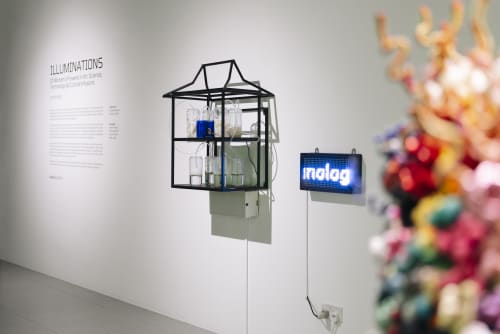Symbiora transforms rice-washing wastewater into clean water. What first drew you to working with such materials and tackling issues of sustainability?
Symbiora continues my earlier explorations in Soya C(O)U(L)ture and A Perfect Marriage. In the first, I used Acetobacter xylinum bacteria to turn domestic food waste into biomaterials, while the second examined the inseparable relationship between water fern and bacteria. These projects inspired me to design Symbiora as an eco-machine, where biological processes form a healthy ecosystem that benefits both human and non-human life in a circular, sustainable way.
As an Indonesian artist working across science and ecology, how do local contexts shape your material and conceptual choices?
In Yogyakarta, we face daily realities of waste, pollution, and economic struggle. At the same time, women have enormous potential to act as agents of change. Through an ecofeminist lens, even a kitchen can become a laboratory where women use simple tools to produce circular and sustainable materials. For me, every woman deserves the right to art, to hack, and to repair.
In Into the Future: Indonesian Women Artists by curator Carla Bianpoen, you said: “When science is involved, I always think about its aesthetic visualisation.” How is this expressed in Symbiora?
I don’t separate art, science, and technology. Painting, programming, or experimenting in a lab all demand creativity and vision, with the main difference lying in protocols. Aesthetics naturally emerges through technical processes. Symbiora reflects this integration: a complex biological system shaped by Donna Haraway’s idea of sympoiesis, making-with others. In it, humans and non-humans co-create ecosystems that nurture one another.
What ecological or social issues are you most interested in addressing through future projects?
I want to focus on Gender and Climate Futures, where women and marginalised communities play central roles in addressing the climate crisis. Patriarchal and extractive systems created much of the damage we now face, so it is vital to create space for these communities to lead the futures ahead.
You co-founded HONF and the XXLab female collective. How do collaborations shape your process and outcomes?
When HONF began, I assumed gender was not an issue in working with art, science, and technology. But through open workshops with women and trans participants, I realised there were systemic barriers and biases. This led to the creation of XXLab, a collective where women and trans voices could explore art, science, and technology beyond the male-dominated perspective.
When people leave this exhibition, what do you hope they carry with them?
I hope they leave with a deeper sense of connection between humans and non-humans, seen through a female perspective. Most of all, I want them to feel that sustainability is rooted in relationships of care, relationships that can transform our present and shape more just and ecological futures.
ILLUMINATIONS of Women’s Prowess in Art, Science, Technology and Cultural Infusions is on view at Cuturi Gallery from 27 September to 1 November, 2025. For more information, please click here.
Interview Courtesy of Irene Agrivina and Cuturi Gallery, Edited by Roxana Yeo, Sept 2025.

